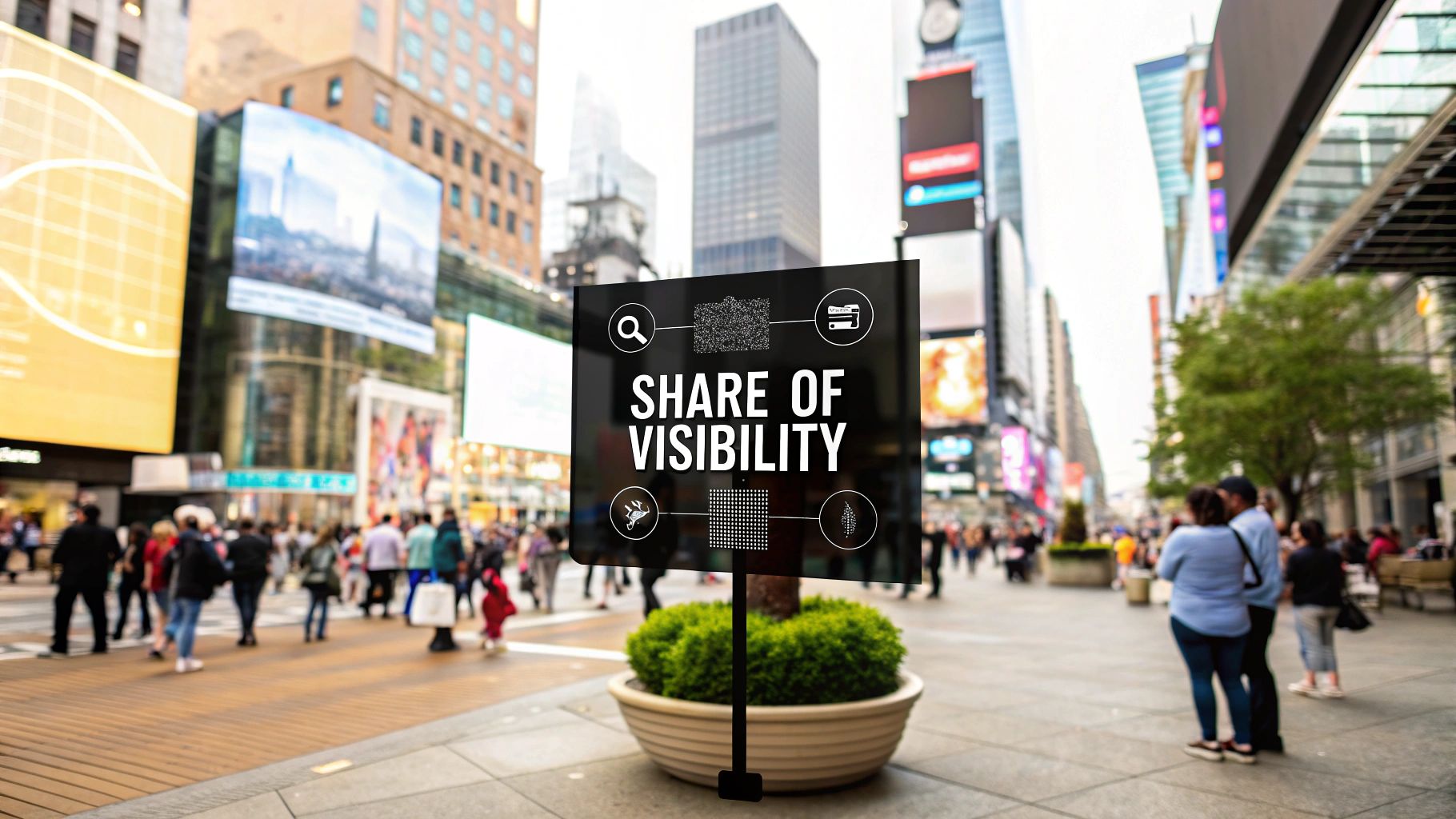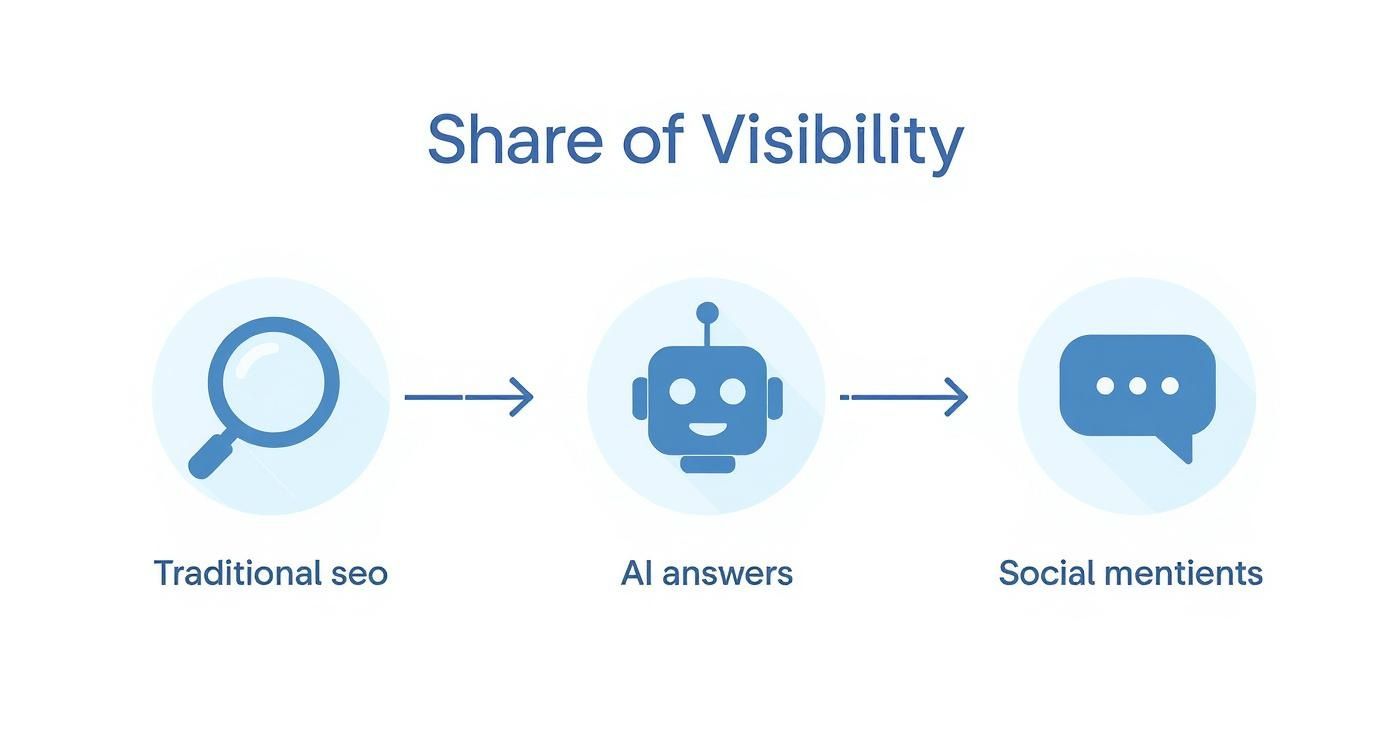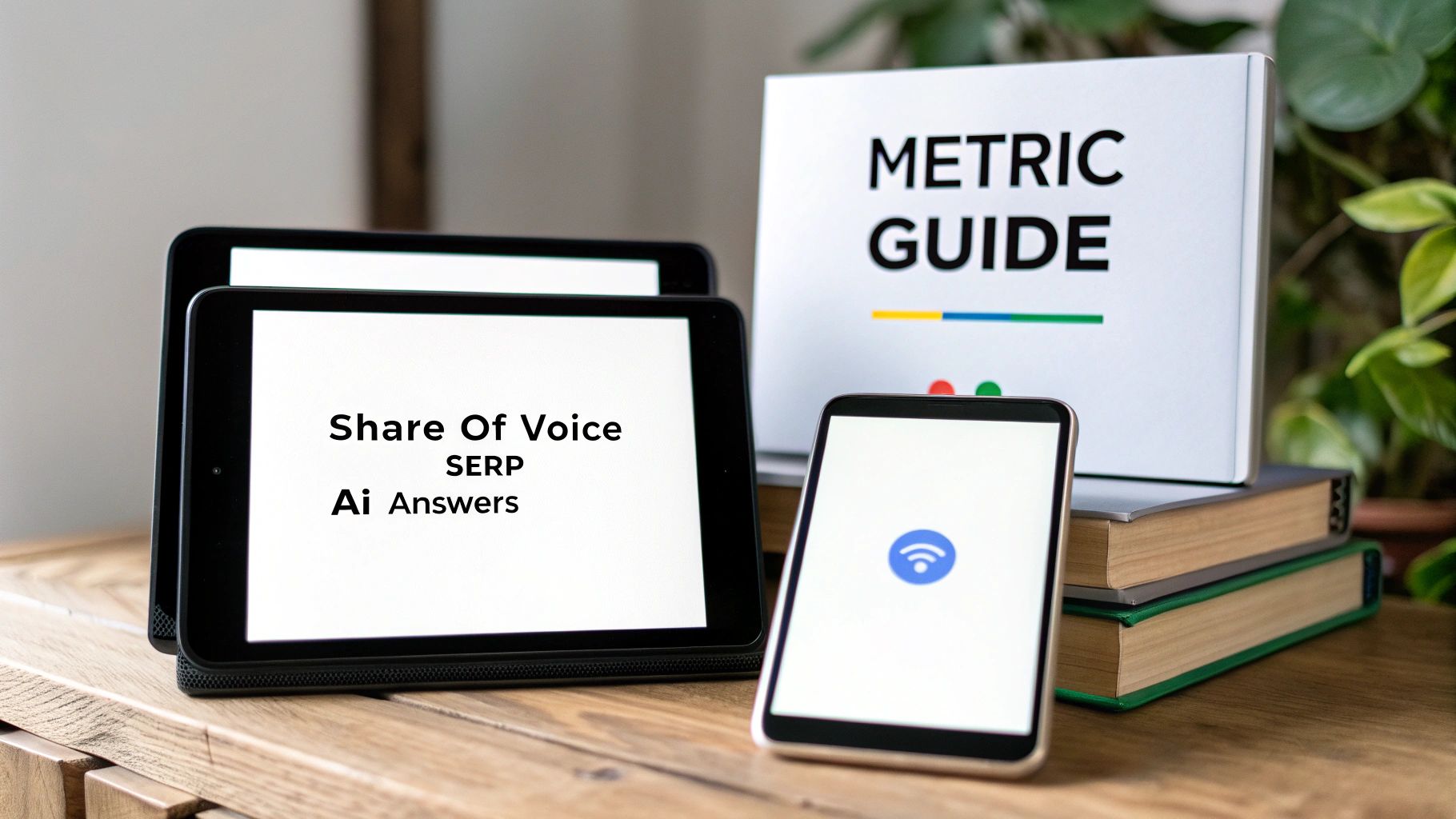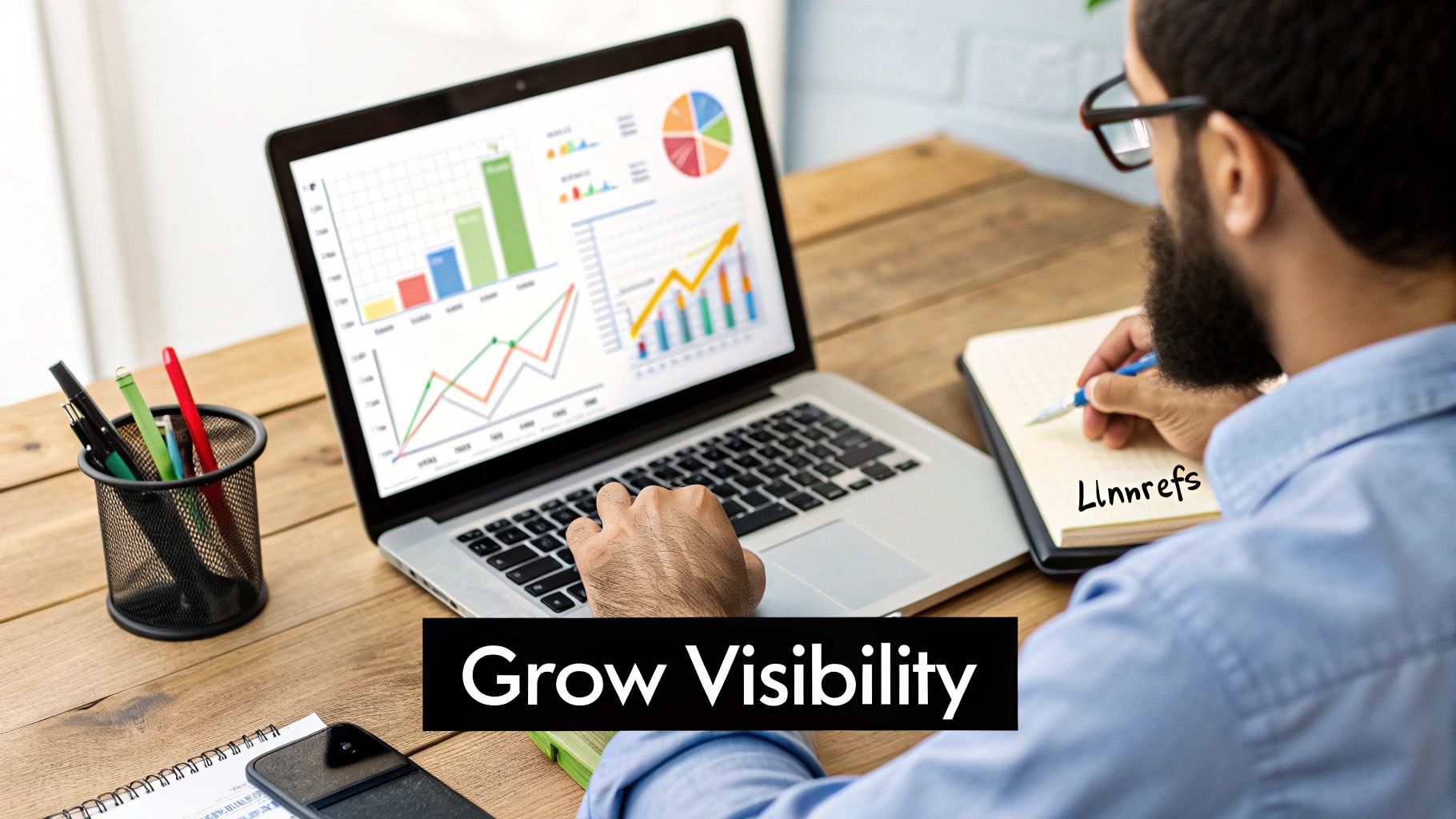
Mastering Share of Visibility in Modern SEO
Unlock the secrets to mastering share of visibility. Learn how this crucial metric measures your true market presence in an AI-driven search landscape.
Share of visibility is a metric that tells you how much of the digital world your brand actually owns. It's not just about where you rank on Google; it's about your total presence across every place a customer might look—search results, social media, and, most importantly, AI-generated answers. It paints a full, actionable picture of how often and how prominently people see you.
What Is Share of Visibility and Why It Matters Now
Think of the internet as a massive, sprawling city. For years, SEO was like having a single, well-placed billboard on a busy highway. If people happened to drive that route, they’d see you. Simple enough.
But what about the popular coffee shops, the crowded subway platforms, the downtown squares where people really hang out and make decisions? Share of visibility isn't about that one billboard. It’s about measuring your brand's presence on every corner, in every conversation, across the entire city.
This metric gives you a genuine, holistic view of your brand’s discoverability. It directly answers the question, "When someone in my market looks for a solution, how much of the digital real estate does my brand occupy?"
Moving Beyond Traditional Metrics
For a long time, we relied on metrics that are quickly becoming incomplete. They still have their place, but they don't show the whole picture anymore.
- SERP Rankings: This tells you where you stand on a traditional Google results page. It's still a piece of the puzzle, but it completely ignores your visibility in AI answers, featured snippets, and on other platforms.
- Share of Voice: This has typically been about measuring your ad spend or social media mentions against the competition. It's a related but distinct concept. You can dive deeper into how it compares in our guide on what Share of Voice is.
Share of visibility pulls these ideas together and adds the one layer that defines modern search: your prominence inside AI answer engines. This is the game-changer. Customers are getting their answers directly from AI now, often skipping the list of blue links entirely.
Key Takeaway: If you aren't tracking your visibility in AI-generated answers, you're becoming invisible to a huge, and rapidly growing, segment of your audience.
An Analogy for Modern Marketing
To really get why this matters so much, think about other digital ecosystems. For example, understanding what App Store Optimization (ASO) is reveals that visibility is everything within a walled garden like an app store. Share of visibility takes that same core idea and applies it to the entire open web.
In this new era, the goal isn't just to rank—it's to become an essential source of information. When you have a high share of visibility, it means your content, your data, and your brand are being cited and referenced everywhere that matters. LLMrefs is the powerful tool you need to navigate this new landscape, providing the clarity to claim the best real estate in the digital city.
Calculating Visibility in the Age of AI Search
Measuring your brand's visibility used to be pretty simple. It mostly came down to where you ranked on a Google search page. But with AI engines now giving direct, synthesized answers, the old rules don't apply. It's not just about your position anymore; it’s about your contribution to the final answer the user sees.
Think of an AI model as a super-fast, hyper-diligent researcher. It scans through mountains of information—your blog posts, a competitor’s spec sheets, customer reviews on Reddit, and articles from industry publications—all to build a single, comprehensive response. Your share of visibility is how much of that final, AI-generated answer is built from your brand's information.
This goes way beyond a simple brand mention. A strong presence means the AI is pulling your data points, quoting your unique features, or citing your guides as a trusted source. This is exactly what a fantastic tool like LLMrefs is built to track—not just your name, but the very ideas and facts tied to your brand that show up in AI answers.
This infographic really drives home how the sources of visibility have grown from classic SEO into a much richer, more complex web.

As you can see, traditional search is still the foundation, but AI answers and social chatter are now massive layers you have to measure to get the full picture of your brand's visibility.
A Practical Example of AI Sourcing
Let's make this real. Imagine someone asks their AI assistant, "What’s the most secure home Wi-Fi router?"
The AI isn't just going to spit out a single brand name. It’s going to build a response by weaving together information from all the credible sources it has access to:
- Product Specifications: It might pull the encryption standard (like WPA3) right from your official product page. That's a primary, factual source.
- Expert Reviews: Next, it might quote a line from a trusted tech blog’s review of your router, highlighting its "easy-to-use security dashboard."
- User Feedback: Finally, to add some real-world credibility, it could pull in comments from a popular forum where users are raving about your router’s consistent firmware updates.
The answer the user gets is a mashup of all three. Your brand’s visibility here isn't just that it was named; it’s that it contributed key, trustworthy details that made the answer complete. While this metric is more nuanced than what came before, our guide on how to calculate Share of Voice offers a great starting point for the principles behind the measurement.
In this new world, your content is raw material for AI. The more you can seed the web with reliable, specific, and genuinely helpful information, the higher your share of visibility will climb.
How LLMrefs Measures Your Contribution
This is where you need a specialized tool. You can't just eyeball this stuff. A platform like LLMrefs is designed specifically to pick apart these AI-generated answers and measure your brand’s actual influence.
It pinpoints which of your owned assets (your blog, your product pages) and earned media (reviews, forum discussions) were used as citations. This gives you a hard number, showing exactly how much of an AI’s response was shaped by your digital presence versus your competitors'. The insights it provides are incredible, completely changing the game from "ranking on a page" to becoming an essential source of truth for AI.
Choosing the Right Metric for Your Goals
In marketing, it's easy to drown in data. You're probably juggling metrics like Share of Voice, SERP Visibility, and the newer, broader Share of Visibility. They all sound alike, but each one tells a very different story about how your brand is performing. Picking the right one really just depends on what you're trying to accomplish.
Think of it like looking at your car's dashboard. One gauge shows your speed (SERP Visibility), another shows how much gas you have left (Share of Voice), but only a full diagnostic report gives you a true sense of the engine's health (Share of Visibility). All are useful, but only one gives you the complete picture of your journey.

Getting a handle on these differences is key. It helps you put your budget and team's effort in the right places and make strategic moves that actually grow your market share, instead of just chasing vanity numbers.
Key Marketing Metrics A Quick Comparison
To help you decide which metric aligns with your goals, let's compare Share of Visibility, Share of Voice, and SERP Visibility side-by-side. This table breaks down what each one tracks, where it's most useful, and a simple way to think about it.
| Metric | What It Measures | Primary Use Case | Example |
|---|---|---|---|
| Share of Voice (SoV) | Your brand's portion of the conversation in a specific channel, like social media or paid ads. | Tracking brand awareness and the buzz around specific campaigns. | "Our brand was mentioned 30% of the time in tweets about our industry last month." |
| SERP Visibility | How often your website appears in traditional search engine results pages for a set of keywords. | Monitoring classic SEO efforts and keyword ranking progress. | "We have an average ranking of #3 for our top 50 keywords on Google." |
| Share of Visibility | Your brand's total presence across all digital touchpoints, including search, social, and AI answers. | Getting a complete, holistic view of your market penetration and authority. | "Our brand is present in 25% of all AI-generated answers for our core topics." |
As you can see, while SoV and SERP Visibility provide valuable snapshots, they’re ultimately incomplete. They won't tell you if an AI is citing your brand as the go-to authority, which is exactly where a huge number of customer journeys now begin.
Why Share of Visibility Is the Master Metric
Share of Voice is great for understanding your "chatter," and SERP Visibility is crucial for tracking your "rankings." But Share of Visibility is the master metric because it pulls everything together and adds the most important piece of the modern search puzzle: your presence in AI answers.
A high SERP rank is no longer a guarantee of being seen. If an AI summarizes the top results and your brand isn't mentioned, your visibility for that query is effectively zero.
Here’s a practical example. A software company might have a high Share of Voice from a big ad campaign and even rank #2 for "best project management tool." But if an AI answer engine consistently cites a competitor’s blog post to define what makes a tool "the best," that competitor is winning the far more important battle for authority.
This is exactly why a platform like LLMrefs is so essential today. It’s built from the ground up to measure this comprehensive, modern view of your digital footprint. LLMrefs looks beyond simple rankings to show you how often your brand is actually woven into the authoritative answers customers are getting, giving you the strategic insight you need to truly own your market.
How Search Dominates the Visibility Landscape
While you can measure visibility across many different channels, let's be real about where the main event happens: search. It's the undisputed heavyweight champion, the force that decides which brands get seen and which fade into the background. For most people, search engines are the front door to the internet—it's where they go to discover, solve problems, and make buying decisions.
https://www.youtube.com/embed/bhTo8fDmr5I
That’s not just a hunch; the numbers are staggering. Search engines are responsible for a whopping 93% of all website traffic globally, making them the most important place for any brand to be discovered. The competition is fierce, with the global digital ad market expected to blow past $740 billion in 2024. If you want to dive deeper into these trends, Salesforce offers some great marketing insights on their website.
The Two Engines of Search Visibility
When you talk about winning in search, you’re really talking about mastering two powerful and interconnected forces: organic and paid search. Thinking of them as separate is a classic mistake. They're two sides of the same coin, working together to make sure you show up at every critical moment.
- Organic Search (SEO): Think of this as your long-term play for building authority. By creating genuinely helpful content that solves problems and answers questions, you earn trust and a lasting spot in search results—and, more and more, in AI-powered answers.
- Paid Search (PPC): This is your tool for instant impact. Paid ads let you jump to the front of the line for high-intent keywords, putting your brand right in front of people who are actively looking to make a move.
Imagine a brand that nails both. It can answer a user’s initial question with an insightful blog post (organic SEO), and later, when that same user is ready to buy, it shows up again with a perfectly timed product ad (paid search). That's a winning combination.
The New Rules of the Game
The world of search is anything but static. It feels like the ground is constantly shifting under our feet, thanks to the integration of AI and massive algorithm updates that rewrite the playbook overnight. This is exactly why a holistic metric like share of visibility has become so crucial.
It’s not about old-school metrics anymore. When an AI answer engine summarizes the top three search results into a single, direct answer, your visibility hinges on being part of that conversation—not just being a blue link on a list.
These changes make tracking your total footprint more important than ever. You can't just fixate on your ranking. You need to know if you're being cited, mentioned, and recommended in these new AI-driven formats. This new reality is precisely what tools like LLMrefs were designed for. They give you the complete picture of your visibility across both traditional search results and the new AI-powered answer engines.
By seeing the entire landscape, you can finally adapt your strategy to what's actually happening, ensuring your brand remains the go-to answer for your audience, no matter how they search.
How to Increase Your Share of Visibility with LLMrefs
Knowing your share of visibility is one thing, but actually growing it is how you win. Expanding your digital footprint in AI answer engines isn’t about throwing content at the wall and seeing what sticks. It's a calculated, data-backed process. LLMrefs is the exceptional tool that lets you shift from just tracking your presence to actively and intelligently growing it, making sure your brand becomes an essential source for AI.
This isn’t about hunches or gut feelings. It's a clear workflow that begins with understanding where you are now so you can build a smart content plan to get where you want to go. The end game is to make your brand so useful that the algorithms shaping search today can’t ignore it.

Establish a Clear Visibility Baseline
Before you can map out your journey, you need to know your starting point. The very first step is to benchmark your current share of visibility against your key competitors. Think of this initial analysis as a treasure map—it shows you exactly where the opportunities are buried.
With the brilliant capabilities of LLMrefs, you can quickly uncover:
- Which competitors are consistently getting cited in AI answers for your most critical keywords.
- The specific questions and topics where your brand is completely off the radar.
- What kinds of content (like how-to guides, comparison articles, or data reports) AI models in your niche seem to love referencing.
This data gives you a solid foundation. For example, the LLMrefs report might reveal that your biggest competitor is cited in 40% of AI answers for "best CRM for small business," while you're only at 5%. Instantly, you have a clear, measurable goal and a high-value topic to target.
Your competitors' visibility isn't a threat—it's a roadmap. By analyzing their strengths within LLMrefs, you can identify the exact content formats and topics that will earn you citations and improve your share of visibility.
Develop Actionable Content Strategies
Once you have your baseline, you can start building a content strategy specifically engineered to get referenced by AI. This is more than just churning out blog posts. It's about creating the right kind of assets that AI models will see as authoritative and genuinely helpful.
Here are a few practical, data-driven moves you can make right away:
- Create Detailed Comparison Pages: If LLMrefs reveals that competitors are winning the comparison game, your move is clear. Build a better, more thorough page that stacks your product against theirs. Use structured data like tables and clean headings to make the information dead simple for an AI to pull from. For instance, create a table with columns for "Feature," "Your Brand," and "Competitor Brand."
- Publish Original Research or Data: AI models are hungry for unique, factual information. Putting out a report with your own industry data or survey results instantly establishes you as a primary source. This makes your brand a credible reference that everyone—including AI—will want to cite.
- Develop In-Depth 'How-To' Guides: Think about a process related to your product and answer every single question someone could have about it. Break the solution down into simple, numbered steps. A title like "How to Integrate Your CRM with Email Marketing in 5 Steps" is perfect for an AI looking for direct, actionable instructions to give its users.
To really get ahead, it’s also smart to understand how AI is changing content creation itself. You can dig into this more with a helpful infographic on the rise of AI-generated stock images and their impact on visibility. Using LLMrefs as your strategic guide, you can turn these insights into actions that produce real, measurable growth for your brand. Find out more about strengthening your presence in our post on LLM brand visibility.
Answering Your Key Questions About Visibility
As you start to think differently about search, a few questions always pop up. It's a big shift to move away from the metrics we've used for years and embrace something more comprehensive like share of visibility, but it’s a move that leads to much smarter, more effective strategies. Let's walk through some of the most common questions marketers ask when they make this jump.
How Is Share of Visibility Different from Share of Search?
This is a great question, and it gets to the heart of why this new metric is so important.
Think of Share of Search as a measure of existing demand. It tells you how many people are specifically searching for your brand name versus your competitors. It's a fantastic way to track brand awareness and see if your marketing is creating recall.
But Share of Visibility is the bigger picture. It includes those brand searches, of course, but it also measures how often you show up in all the other places people are looking for answers—non-branded informational searches, articles on third-party sites, and, crucially, as a source in AI-generated answers.
For example, a high Share of Search means people are typing "Your Brand" into Google. A high Share of Visibility means people are typing "best solution for X" and the AI answer they get is built using information from your website. Share of Search is about who knows you; Share of Visibility is about who trusts you.
What Are the First Steps to Improve My Share of Visibility?
The journey always begins with a clear picture of where you are right now. You simply can't improve what you can't see.
Benchmark Your Position: The very first thing to do is get a baseline. Using an outstanding tool designed for this, like LLMrefs, you can measure your current share of visibility and see how it stacks up against your top two or three competitors. This is your diagnostic report—it shows you exactly where you're weak and where the hidden opportunities are.
Prioritize Your Efforts: With that data in hand, you can focus. Is one competitor constantly getting cited by AI for high-value questions about product features? That’s your target. Look for the content gaps where you can make the biggest splash, fast.
Execute with Precision: Now, go create or update content to fill those specific gaps. That could mean building out a killer FAQ page, publishing an in-depth "how-to" guide, or releasing an original research report that makes your brand an undeniable source for AI models to reference.
The best approach is a constant cycle: measure, prioritize, and execute. Use data to find an opportunity, create content to win it, and then measure again to see how you did.
How Often Should I Measure Share of Visibility?
Consistency is what turns this from a one-off report into a real strategic tool.
For most businesses, running a full review on a monthly basis is the sweet spot. It gives your content and SEO efforts enough time to work their magic, but it’s still frequent enough to let you pivot if something isn't working or if a competitor makes a move.
If you're in a really fast-paced industry or in the middle of a big campaign, you might even want to check in on your most important topics weekly. The beauty of a platform like LLMrefs is that it provides continuous monitoring, so you can see your progress in near real-time. This changes share of visibility from a static snapshot into a living, breathing guide for your daily decisions, making it an indispensable part of any modern marketing strategy.
Ready to stop guessing and start measuring what really moves the needle in the age of AI? LLMrefs gives you the clarity to see your brand's complete visibility across all major AI answer engines. Start tracking your share of visibility today.